Aert de Gelder
Aert de Gelder (Dutch: [ˈaːrt də ˈɣɛldər] (![]()
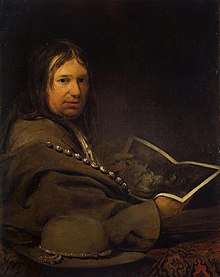
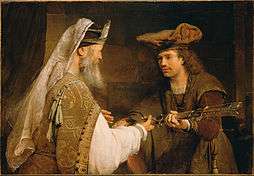
Biography
De Gelder was born and died in Dordrecht. He was one of Rembrandt’s last pupils while in Amsterdam, studying in his studio from 1661 to 1663. He was not only one of the most talented of Rembrandt’s pupils, but also one of his most devoted followers, for he was the only Dutch artist to paint in the tradition of Rembrandt's late style into the 18th century. Following Rembrandts lead, De Gelder would paint such artworks as "The Baptism of Christ" and "Ahimelech Giving the Sword of Goliath to David". Story telling, transparent emotionalism, and an emphasis on the humanity of biblical characters are the distinguishing elements of this style. This contrasted with the courtly and distant emotions and imagery of other artists, even in the Renaissance period.
Style
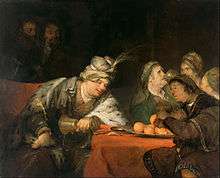
As author of biblical scenes and portraits of his style was inspired by Rembrandt's, using his artistic ideas, well into the eighteenth century, without being influenced by contemporary new fashions. From the artistic point of view his work can not be considered as passive imitation of the master, indeed it stands for inventiveness in the narrative, taste for the theatrical and a strong emotional charge of the characters. All these traits made him one of the most important interpreters of Dutch painting of the late seventeenth century.
Works
- Esther and Mordecai (Budapest, Museum of Fine Arts}
- Judah and Tamar, c. 1681 (Vienna, Gemäldegalerie of the Academy of Fine Arts)
- King David, c. 1683 (Amsterdam, Rijksmuseum, inv A 2695)
- The Toilet of Esther, c. 1684 (Munich, Alte Pinakothek )
- Portrait of Tsar Peter the Great (Amsterdam, Rijksmuseum?)
- Self Portrait as Zeuxis (Frankfurt am Main, Städel, inv. no. 1015))
- Passion Series c. 1715 (22 paintings, including ten in Aschaffenburg, Schloss Johannisburg, and two in Amsterdam, Rijksmuseum)
- Portrait of Hermannus Boerhaave with his wife and daughter, c. 1724 (Amsterdam, Rijksmuseum, inv A 4034)
- The marriage contract, c. 1670 (Brighton Museum & Art Gallery)
- Simeon's song of praise. 1700–1710 (The Hague, Royal Picture Gallery Mauritshuis)
- Baptism of Christ, c. 1710 (Cambridge, Fitzwilliam Museum)
_-_Aert_de_GELDER_-_Google_Cultural_Institute.jpg)
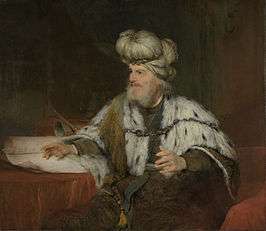 "King David" by Aert de Gelder, Rijksmuseum, Amsterdam
"King David" by Aert de Gelder, Rijksmuseum, Amsterdam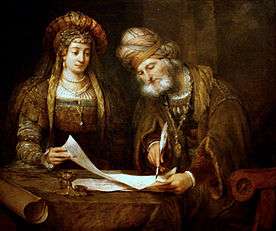
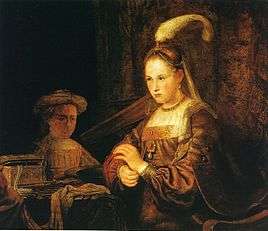 A lady at her toilet
A lady at her toilet Abraham and the Angels
Abraham and the Angels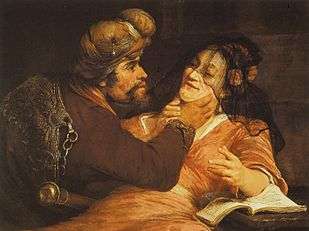
_-_WGA8523.jpg) Bride (Esther Bedecked)
Bride (Esther Bedecked)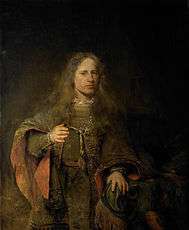 Portrait of Ernst van Beveren (1660–1722)
Portrait of Ernst van Beveren (1660–1722) Simeon's Song of Praise (1700–1710)
Simeon's Song of Praise (1700–1710)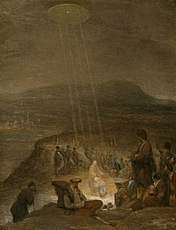 "The Baptism of Christ" (c.1710)
"The Baptism of Christ" (c.1710)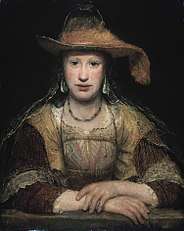 Portrait of an unknown woman (c.1685)
Portrait of an unknown woman (c.1685)
See also
References
- The Getty Union Artist's Name List only mentions "Aert", but the Rijksmuseum, Amsterdam uses "Arent".
External links

- National Gallery, London, "Aert de Gelder"
- Paintings and biography at artbible.info
- Works and literature on Aert de Gelder at PubHist
- Dutch and Flemish paintings from the Hermitage, an exhibition catalog from The Metropolitan Museum of Art (fully available online as PDF), which contains material on Aert de Gelder (cat. no. 9)